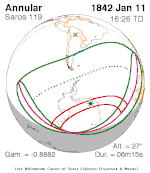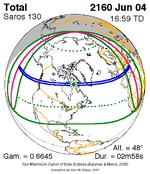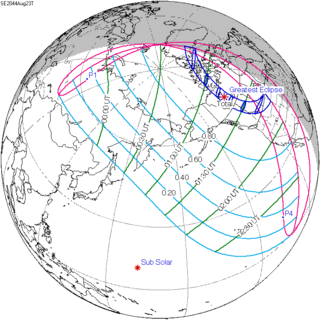Solar eclipse of August 23, 2044
| Solar eclipse of August 23, 2044 | |
|---|---|
| Type of eclipse | |
| Nature | Total |
| Gamma | 0.9613 |
| Magnitude | 1.0364 |
| Maximum eclipse | |
| Duration | 124 s (2 min 4 s) |
| Coordinates | 64°18′N 120°24′W / 64.3°N 120.4°W |
| Max. width of band | 453 km (281 mi) |
| Times (UTC) | |
| Greatest eclipse | 1:17:02 |
| References | |
| Saros | 126 (49 of 72) |
| Catalog # (SE5000) | 9606 |
A total solar eclipse will occur at the Moon's descending node of orbit between Monday, August 22 and Tuesday, August 23, 2044,[1] with a magnitude of 1.0364. A solar eclipse occurs when the Moon passes between Earth and the Sun, thereby totally or partly obscuring the image of the Sun for a viewer on Earth. A total solar eclipse occurs when the Moon's apparent diameter is larger than the Sun's, blocking all direct sunlight, turning day into darkness. Totality occurs in a narrow path across Earth's surface, with the partial solar eclipse visible over a surrounding region thousands of kilometres wide. Occurring about 2.1 days after perigee (on August 21, 2044, at 0:00 UTC), the Moon's apparent diameter will be larger.[2]
This will be the last of 41 umbral solar eclipses in Solar Saros 126.
Path
[edit]Totality will be visible in the evening of August 22 across:[3]
- Northwestern Greenland
- In Canada:
- Northern and western Nunavut
- Central Northwest Territories
- Extreme southeast Yukon
- Eastern British Columbia, including Dawson Creek and Fernie
- Much of Alberta including Edmonton, Calgary, and Lethbridge
- Southwestern Saskatchewan, including Swift Current
- In the United States:
- The northeastern half of Montana. Glacier National Park, Great Falls, Lewistown, and Forsyth will be just inside the path of totality.
- Western North Dakota, including Williston, Minot, and Dickinson
- Extreme northwest South Dakota
A partial solar eclipse will be visible in Siberia in the morning of August 23, and throughout western Canada and United States until sunset on August 22.
The greatest duration of the total eclipse will be observed in the Northwest Territories, approximately 60 miles (97 km) southeast of Great Bear Lake.[4]
Images
[edit]Eclipse details
[edit]Shown below are two tables displaying details about this particular solar eclipse. The first table outlines times at which the moon's penumbra or umbra attains the specific parameter, and the second table describes various other parameters pertaining to this eclipse.[5]
| Event | Time (UTC) |
|---|---|
| First Penumbral External Contact | 2044 August 22 at 23:10:51.7 UTC |
| Equatorial Conjunction | 2044 August 23 at 00:27:10.1 UTC |
| First Umbral External Contact | 2044 August 23 at 00:46:01.0 UTC |
| First Central Line | 2044 August 23 at 00:49:11.6 UTC |
| First Umbral Internal Contact | 2044 August 23 at 00:52:44.5 UTC |
| Ecliptic Conjunction | 2044 August 23 at 01:07:14.0 UTC |
| Greatest Duration | 2044 August 23 at 01:16:35.8 UTC |
| Greatest Eclipse | 2044 August 23 at 01:17:01.7 UTC |
| Last Umbral Internal Contact | 2044 August 23 at 01:41:52.4 UTC |
| Last Central Line | 2044 August 23 at 01:45:22.9 UTC |
| Last Umbral External Contact | 2044 August 23 at 01:48:31.2 UTC |
| Last Penumbral External Contact | 2044 August 23 at 03:23:35.9 UTC |
| Parameter | Value |
|---|---|
| Eclipse Magnitude | 1.03644 |
| Eclipse Obscuration | 1.07420 |
| Gamma | 0.96130 |
| Sun Right Ascension | 10h10m33.4s |
| Sun Declination | +11°16'02.2" |
| Sun Semi-Diameter | 15'48.9" |
| Sun Equatorial Horizontal Parallax | 08.7" |
| Moon Right Ascension | 10h12m17.2s |
| Moon Declination | +12°07'34.4" |
| Moon Semi-Diameter | 16'19.6" |
| Moon Equatorial Horizontal Parallax | 0°59'55.1" |
| ΔT | 81.0 s |
Eclipse season
[edit]This eclipse is part of an eclipse season, a period, roughly every six months, when eclipses occur. Only two (or occasionally three) eclipse seasons occur each year, and each season lasts about 35 days and repeats just short of six months (173 days) later; thus two full eclipse seasons always occur each year. Either two or three eclipses happen each eclipse season. In the sequence below, each eclipse is separated by a fortnight.
| August 23 Descending node (new moon) |
September 7 Ascending node (full moon) |
|---|---|
 |

|
| Total solar eclipse Solar Saros 126 |
Total lunar eclipse Lunar Saros 138 |
Related eclipses
[edit]Eclipses in 2044
[edit]- An annular solar eclipse on February 28.
- A total lunar eclipse on March 13.
- A total solar eclipse on August 23.
- A total lunar eclipse on September 7.
Metonic
[edit]- Preceded by: Solar eclipse of November 4, 2040
- Followed by: Solar eclipse of June 11, 2048
Tzolkinex
[edit]- Preceded by: Solar eclipse of July 13, 2037
- Followed by: Solar eclipse of October 4, 2051
Half-Saros
[edit]- Preceded by: Lunar eclipse of August 19, 2035
- Followed by: Lunar eclipse of August 29, 2053
Tritos
[edit]- Preceded by: Solar eclipse of September 23, 2033
- Followed by: Solar eclipse of July 24, 2055
Solar Saros 126
[edit]- Preceded by: Solar eclipse of August 12, 2026
- Followed by: Solar eclipse of September 3, 2062
Inex
[edit]- Preceded by: Solar eclipse of September 13, 2015
- Followed by: Solar eclipse of August 3, 2073
Triad
[edit]- Preceded by: Solar eclipse of October 23, 1957
- Followed by: Solar eclipse of June 25, 2131
Solar eclipses of 2044–2047
[edit]This eclipse is a member of a semester series. An eclipse in a semester series of solar eclipses repeats approximately every 177 days and 4 hours (a semester) at alternating nodes of the Moon's orbit.[6]
The partial solar eclipses on June 23, 2047 and December 16, 2047 occur in the next lunar year eclipse set.
| Solar eclipse series sets from 2044 to 2047 | ||||||
|---|---|---|---|---|---|---|
| Ascending node | Descending node | |||||
| Saros | Map | Gamma | Saros | Map | Gamma | |
| 121 | February 28, 2044 Annular |
−0.9954 | 126 | August 23, 2044 Total |
0.9613 | |
| 131 | February 16, 2045 Annular |
−0.3125 | 136 | August 12, 2045 Total |
0.2116 | |
| 141 | February 5, 2046 Annular |
0.3765 | 146 | August 2, 2046 Total |
−0.535 | |
| 151 | January 26, 2047 Partial |
1.045 | 156 | July 22, 2047 Partial |
−1.3477 | |
Saros 126
[edit]This eclipse is a part of Saros series 126, repeating every 18 years, 11 days, and containing 72 events. The series started with a partial solar eclipse on March 10, 1179. It contains annular eclipses from June 4, 1323 through April 4, 1810; hybrid eclipses from April 14, 1828 through May 6, 1864; and total eclipses from May 17, 1882 through August 23, 2044. The series ends at member 72 as a partial eclipse on May 3, 2459. Its eclipses are tabulated in three columns; every third eclipse in the same column is one exeligmos apart, so they all cast shadows over approximately the same parts of the Earth.
The longest duration of annularity was produced by member 11 at 6 minutes, 30 seconds on June 26, 1359, and the longest duration of totality was produced by member 45 at 2 minutes, 36 seconds on July 10, 1972. All eclipses in this series occur at the Moon’s descending node of orbit.[7]
| Series members 36–57 occur between 1801 and 2200: | ||
|---|---|---|
| 36 | 37 | 38 |
 April 4, 1810 |
 April 14, 1828 |
 April 25, 1846 |
| 39 | 40 | 41 |
 May 6, 1864 |
 May 17, 1882 |
 May 28, 1900 |
| 42 | 43 | 44 |
 June 8, 1918 |
 June 19, 1936 |
 June 30, 1954 |
| 45 | 46 | 47 |
 July 10, 1972 |
 July 22, 1990 |
 August 1, 2008 |
| 48 | 49 | 50 |
 August 12, 2026 |
 August 23, 2044 |
 September 3, 2062 |
| 51 | 52 | 53 |
 September 13, 2080 |
 September 25, 2098 |
 October 6, 2116 |
| 54 | 55 | 56 |
 October 17, 2134 |
 October 28, 2152 |
 November 8, 2170 |
| 57 | ||
 November 18, 2188 | ||
Metonic series
[edit]The metonic series repeats eclipses every 19 years (6939.69 days), lasting about 5 cycles. Eclipses occur in nearly the same calendar date. In addition, the octon subseries repeats 1/5 of that or every 3.8 years (1387.94 days). All eclipses in this table occur at the Moon's descending node.
| 22 eclipse events between June 12, 2029 and November 4, 2116 | ||||
|---|---|---|---|---|
| June 11–12 | March 30–31 | January 16 | November 4–5 | August 23–24 |
| 118 | 120 | 122 | 124 | 126 |
 June 12, 2029 |
 March 30, 2033 |
 January 16, 2037 |
 November 4, 2040 |
 August 23, 2044 |
| 128 | 130 | 132 | 134 | 136 |
 June 11, 2048 |
 March 30, 2052 |
 January 16, 2056 |
 November 5, 2059 |
 August 24, 2063 |
| 138 | 140 | 142 | 144 | 146 |
 June 11, 2067 |
 March 31, 2071 |
 January 16, 2075 |
 November 4, 2078 |
 August 24, 2082 |
| 148 | 150 | 152 | 154 | 156 |
 June 11, 2086 |
 March 31, 2090 |
 January 16, 2094 |
 November 4, 2097 |
 August 24, 2101 |
| 158 | 160 | 162 | 164 | |
 June 12, 2105 |
 November 4, 2116 | |||
Tritos series
[edit]This eclipse is a part of a tritos cycle, repeating at alternating nodes every 135 synodic months (≈ 3986.63 days, or 11 years minus 1 month). Their appearance and longitude are irregular due to a lack of synchronization with the anomalistic month (period of perigee), but groupings of 3 tritos cycles (≈ 33 years minus 3 months) come close (≈ 434.044 anomalistic months), so eclipses are similar in these groupings.
| Series members between 1837 and 2200 | ||||
|---|---|---|---|---|
 April 5, 1837 (Saros 107) |
 March 5, 1848 (Saros 108) |
 February 3, 1859 (Saros 109) |
 December 2, 1880 (Saros 111) | |
 August 31, 1913 (Saros 114) |
 July 31, 1924 (Saros 115) |
 June 30, 1935 (Saros 116) | ||
 May 30, 1946 (Saros 117) |
 April 30, 1957 (Saros 118) |
 March 28, 1968 (Saros 119) |
 February 26, 1979 (Saros 120) |
 January 26, 1990 (Saros 121) |
 December 25, 2000 (Saros 122) |
 November 25, 2011 (Saros 123) |
 October 25, 2022 (Saros 124) |
 September 23, 2033 (Saros 125) |
 August 23, 2044 (Saros 126) |
 July 24, 2055 (Saros 127) |
 June 22, 2066 (Saros 128) |
 May 22, 2077 (Saros 129) |
 April 21, 2088 (Saros 130) |
 March 21, 2099 (Saros 131) |
 February 18, 2110 (Saros 132) |
 January 19, 2121 (Saros 133) |
 December 19, 2131 (Saros 134) |
 November 17, 2142 (Saros 135) |
 October 17, 2153 (Saros 136) |
 September 16, 2164 (Saros 137) |
 August 16, 2175 (Saros 138) |
 July 16, 2186 (Saros 139) |
 June 15, 2197 (Saros 140) | |
Inex series
[edit]This eclipse is a part of the long period inex cycle, repeating at alternating nodes, every 358 synodic months (≈ 10,571.95 days, or 29 years minus 20 days). Their appearance and longitude are irregular due to a lack of synchronization with the anomalistic month (period of perigee). However, groupings of 3 inex cycles (≈ 87 years minus 2 months) comes close (≈ 1,151.02 anomalistic months), so eclipses are similar in these groupings.
| Series members between 1801 and 2200 | ||
|---|---|---|
 February 1, 1813 (Saros 118) |
 January 11, 1842 (Saros 119) |
 December 22, 1870 (Saros 120) |
 December 3, 1899 (Saros 121) |
 November 12, 1928 (Saros 122) |
 October 23, 1957 (Saros 123) |
 October 3, 1986 (Saros 124) |
 September 13, 2015 (Saros 125) |
 August 23, 2044 (Saros 126) |
 August 3, 2073 (Saros 127) |
 July 15, 2102 (Saros 128) |
 June 25, 2131 (Saros 129) |
 June 4, 2160 (Saros 130) |
 May 15, 2189 (Saros 131) |
|
References
[edit]- ^ "August 22–23, 2044 Total Solar Eclipse". timeanddate. Retrieved 14 August 2024.
- ^ "Moon Distances for London, United Kingdom, England". timeanddate. Retrieved 14 August 2024.
- ^ "Total Solar Eclipse on August 22–23, 2044: Path Map and Times". www.timeanddate.com. Retrieved 2024-03-23.
- ^ "Greatest Duration of Total Solar Eclipse of 2044 Aug 23". NASA Eclipse Website. NASA. Retrieved 9 September 2017.
- ^ "Total Solar Eclipse of 2044 Aug 23". EclipseWise.com. Retrieved 14 August 2024.
- ^ van Gent, R.H. "Solar- and Lunar-Eclipse Predictions from Antiquity to the Present". A Catalogue of Eclipse Cycles. Utrecht University. Retrieved 6 October 2018.
- ^ "NASA - Catalog of Solar Eclipses of Saros 126". eclipse.gsfc.nasa.gov.





